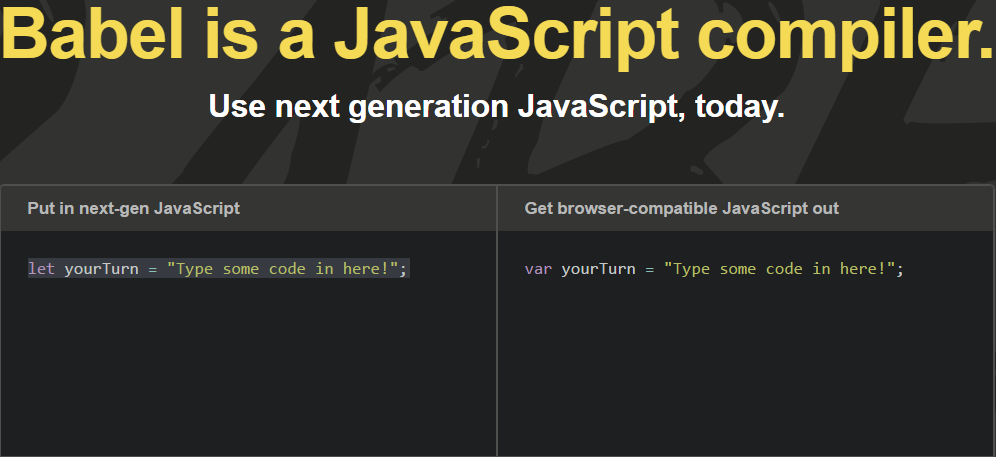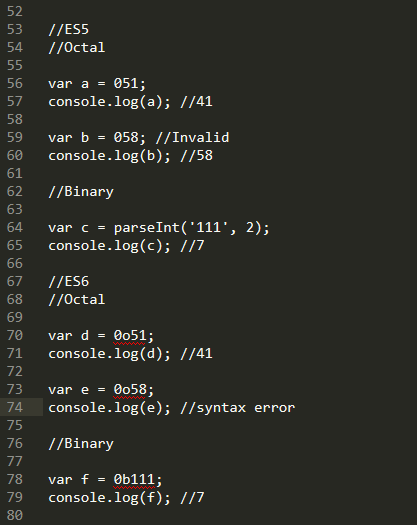ECMAScript 6 - Anthony Russo¶
What is it?¶
ES6, also referred to as "Harmony", is the sixth major update to ECMAScript language. ECMAScript is a set of standards issued that was created for JavaScript. Other languages that follow these standards are JScript and ActionScript. With each update of the standards JavaScript is then updated to comply with these standards. ES6 is compatible with most browsers, however certain features are only available in the most up to date browser. Chrome and Firefox are the most popular among users of ES6. [Allardice]
How is it used?¶
Individuals who wish to use ES6 now may need to use a third party service in order for all to be able to view and use websites created. Even though many browsers like Chrome support 90% of ES6 features, most users who wish to get a head start on using ES6 will need to use a service like Babel which allows a user to write JavaScript in ES6 then converts the code to ES5. [Williams]

History¶
JavaScript was created in late 1996 / early 1997 by Brendan Eich. The first release of JavaScript on the ECMAScript was June of 1997, ES1. Exactly one year later, June 1998, ES2 was released. ES2 only brought minor changes. December 1999 was the first big improvement. ES3 was introduced which included the adoption across all browsers. ES3 also included try / catch, errors, and improved how the string was handled. Almost 10 years passed before the next version was released. July 2008, ES3.1 or ES4 was introduced with a lot of opposition. The initial idea was to completely overhaul JavaScript, with proposed ideas including classes, modules, and static typing. However, many thought this would "break the Internet". The two sides agreed to release a smaller upgrade deemed ES3.1 which eventually became ES5. 2009, ES5 was official released and was the first major upgrade since 1999. ES5 included native JSON support, undefined, infinity values, and more. After the debacle that was ES4, the two opposing sides came together and decided to create the ideas from ES4 in ES6. ES6 features were completed in 2015. ES7 is already on the table for late 2017 / early 2018. [Popoola]
The New Features¶
Classes
Classes are special functions that contains two components, expressions and declarations. A declaration is used to name the class. An expression is a a different way to define a class. Class expressions can be unnamed. Next is the constructor method, which is used for creating an object with a class. Creating a child of a class or sub class of another class is done using "extends". [Classes]

Arrows
Arrows have been a part of JavaScript since ES1. The way arrows are used has changed over time. Today arrows look like this "=>". These same keys can represent a comment when they are used at the beginning of a line. It also represents the "goes to" operator. ES6 turns these keys into a simple function syntax with a single argument (Identifier => Expression), eliminating the need for "function" or "return" and some parentheses. In order to write a function with multiple arguments, using the arrow syntax, parentheses will be needed. [Orendorff]

Modules
Modules allow a user to export variables or functions and import them on a different file. When creating a module, the functions and variables inside are not visible to any outside files without explicitly exporting them. This allows a user to export only certain parts of a function. A user also has to define a keyword to export under. [Modules]

Binary and Octal Literals
Binary and Octal numbers can now be represented with literals. This was not possible in ES5. Binary was only allowed if you used a parseInt. The only way to show octal numbers in ES5 was through the use of (0) as a prefix. If a number is outside of the 0-7 range than the prefixed 0 will be ignored and return decimals. In ES6 instead of returning decimal it will return a syntax error. Binary and Octal are required to be prefixed with "0o" for octal and "0b" for binary. [OctalandBinary]

Promises
Promises have been around awhile, but weren't adopted by JavaScript until ES6. Promises allow users to handle asynchronous processes in a synchronous way. Promises are a value that will be handled at some point in the future. Similar to callbacks in that respect, except with promises the user is guaranteed the same value as before. Promises have three states. Pending, which is waiting for the promise to be fulfilled. Fulfilled, when the the value is passed to the handler. Rejected, the promise is called by the second handler instead of the first. Some negatives of using promises are once you set one you cannot cancel it, also you cannot determine the state of a promise (pending, fulfilled, or rejected). [Atchley]

Conclusion(Personal thoughts/reflection)
Overall I believe ES6 is a very user-friendly update. The key new features highlighted above allow for more concise and organized code. Classes have been in works for a long time and finally implemented in ES6. Arrows allow users to create a function in one line of code. Previously this took multiple lines of code, which allows the user to save time and create more organized code. Modules allow a user to write a function or var in one file, export it, import it in a different file, and use the function or variable in different files without having to rewrite the same code. Previously in ES5 a user was unable to use binary numbers and had to use parseInt to use octal numbers. ES6 changed this allowing users the ability to use both binary and octal numbers. It also changed how users see errors when coding binary and octal, instead of just showing decimal form it now shows error. ES6 had many updates and overall made JavaScript easier and better. ES7 had original plans of being released within the next few years. Leaving many users hungry to see what cool features ES7 will have. [Hoban]
Work Cited¶
| [Hoban] | Hoban, Luke. "ES6features." GitHub. N.p., 24 July 2016. Web. 18 Apr. 2017. |
| [Allardice] | Allardice, James. "Venntro Development." An introduction to ES6 Part 1: Using ES6 Today. N.p., 13 Sept. 2013. Web. 12 Apr. 2017. |
| [Williams] | Williams, Owen. `"6 reasons Web developers need to learn JavaScript ES6 now." <https://thenextweb.com/dd/2016/03/09/6-reasons-need-learn-javascript-es6-now-not-later/#.tnw_R6XrEy5g>`_The Next Web. N.p., 09 Mar. 2016. Web. 12 Apr. 2017. |
| [Popoola] | Popoola, AbdulFattaah. "Posts about JavaScript history on CodeKraft>." CodeKraft. N.p., 28 Mar. 2016. Web. 13 Apr. 2017. |
| [Classes] | "Classes." Mozilla Developer Network. N.p., n.d. Web. 13 Apr. 2017. |
| [Orendorff] | Orendorff, Jason. "ES6 In Depth: Arrow functions." Mozilla Hacks – the Web developer blog. N.p., 4 June 2015. Web. 15 Apr. 2017. |
| [OctalandBinary] | "A Quick Look at Octal and Binary Literals in ES6." JavaScript Tutorial. N.p., n.d. Web. 15 Apr. 2017. |
| [Modules] | "Understanding ES6 Modules." SitePoint. SitePoint, 07 Jan. 2016. Web. 15 Apr. 2017. |
| [Atchley] | Atchley, Dave. "ES6 Promises (the Basics)." Musings of a caffeinated coder. Dave Atchley, 19 Nov. 2015. Web. 15 Apr. 2017. |